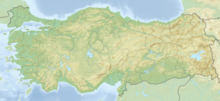Kaunos
Kaunos ( ancient Greek Καῦνος ) was an ancient city in the south-east of the Caria region in Asia Minor near the current town of Dalyan , Muğla Province in Turkey . It was originally by the sea, but now eight kilometers from the sea in the Dalyan (Calbis) delta, which connects Lake Köyceğiz with the Mediterranean , due to the shifting of the coast , it is not completely silted up, but connected to it via marsh waters and waterways.
history
The history of the place goes back to the 10th century BC. BC back. Kaunos was temporarily part of the Attic League and the mainland property of the nearby island of Rhodes (Rhodian Peraia). The elder Pliny also refers to the dependence on Rhodis in his report on the famous ancient artist Protogenes , who worked in the early Hellenistic period. The coins for the Rhodian Peraia , which in the design with the Helios head on the obverse and the rose on the lapel were strongly based on those of the island of Rhodes, were probably minted in Kaunos.
In Roman times, Kaunos was initially part of the province of Asia . At the latest under Trajan , the city is a member of the Lycian League . Whether Kaunos already belonged to the province of Lycia under Claudius or only became part of Lycia when the double province Lycia et Pamphylia was established under Vespasian is a matter of dispute in ancient studies.
The place was considered rich in ancient times, but unhealthy due to its location in the swampy river delta, where pathogens can easily multiply. It was known for its widely exported dried figs . The Greek geographer Strabon wrote: “Kaunos has a ship store and a lockable port. The Veste Imbros lies on a hill above the city. Although the area is blessed with fertility, it is generally believed that the city has unhealthy air in summer and in autumn ... because of the heat and the abundance of fruit ... "
archeology
There are still some remains of the ancient buildings to be seen, especially Carian tombs carved in the rock, dating from the 4th century BC. BC, but also a Roman theater , large thermal baths , as well as a nymphaeum , an agora , temple , a gymnasium , port facilities and an acropolis . Numerous Greek inscriptions of the city have also been preserved. The baetyl of Kaunos, over 4 meters high and often depicted on its silver coins, has since been found.
tourism
The area around Dalyan, Kaunos, the rock tombs and the Dalyan Delta is due to its location between the holiday centers of Marmaris and Oludeniz a much-visited tourist attraction today.
literature
- Britta Özen-Kleine, Soner Özen: New research in the ancient city of Kaunos. In: M. Koch (Ed.), Contributions to the international symposium on archeology in the greater region March 7–9, 2014 in Otzenhausen (Otzenhausen 2015) pp. 67–82
- Baki Ögün, Cengiz Işik: Kaunos - Kbid. The results of 35 years of research (1966-2001) . Izmir 2001. ISBN 975-93042-3-6
- Christian Marek , The inscriptions of Kaunos ( Vestigia , 35) , Munich 2006.
Web links
Remarks
- ↑ Gizem Baybaş: Spatial Decision Support System for Archaeological Application: A Case Study for Kaunos Archaeological Site , thesis, 2013, p. 31 ( online , PDF).
- ↑ Pliny, Naturalis historia 35, 101.
- ^ Szaivert / Sear, Greek Coin Catalog, Volume 2, Munich 1983, page 187
- ^ Christian Marek: Kaunos and Lykien . In: Adalya . tape 14 , 2011, p. 57-62 .
- ↑ Sencer Şahin: Parerga on the Stadiasmus Patarensis (9): The Kauno-Lycian question . In: Gephyra . tape 10 , 2013, p. 32–37 ( online [PDF]).
Coordinates: 36 ° 50 ′ N , 28 ° 37 ′ E








